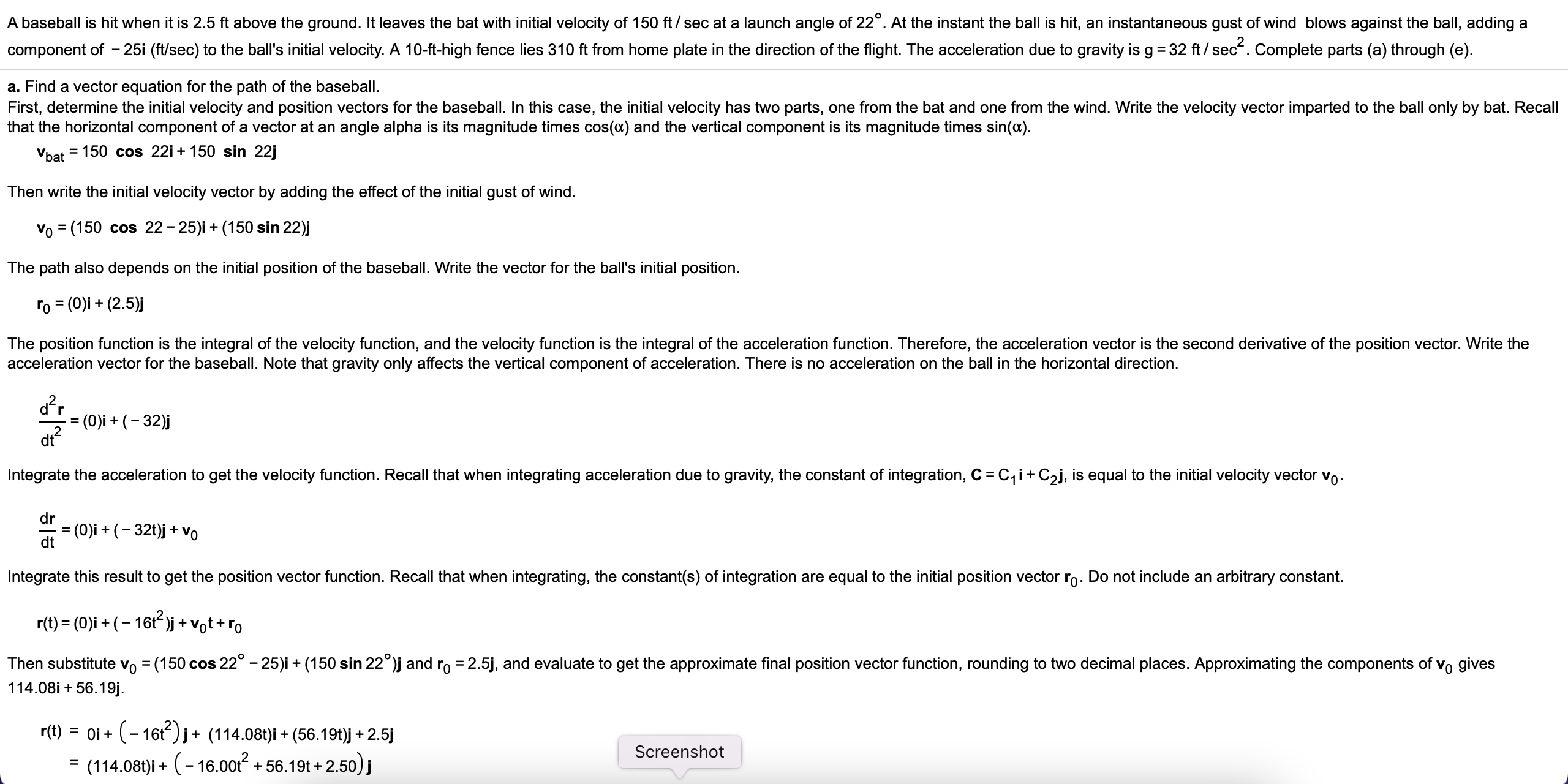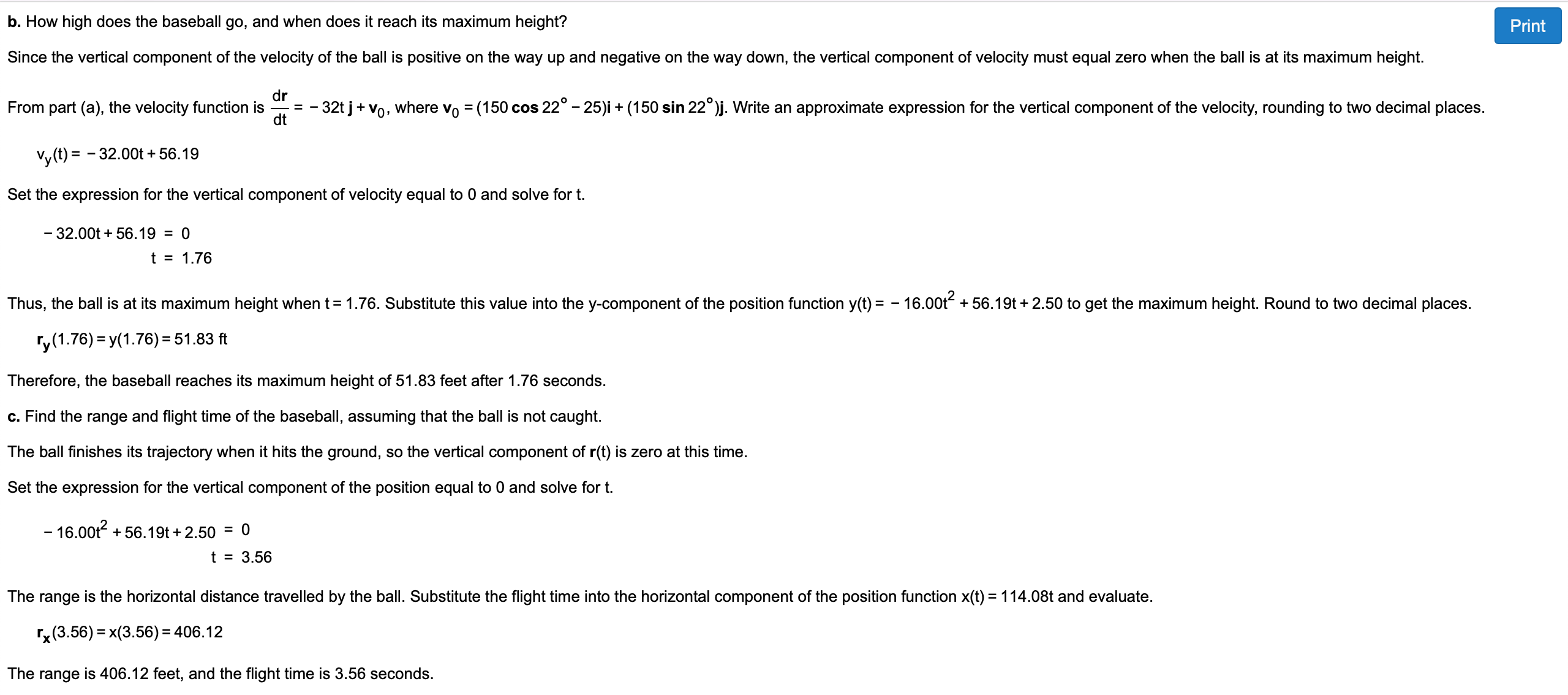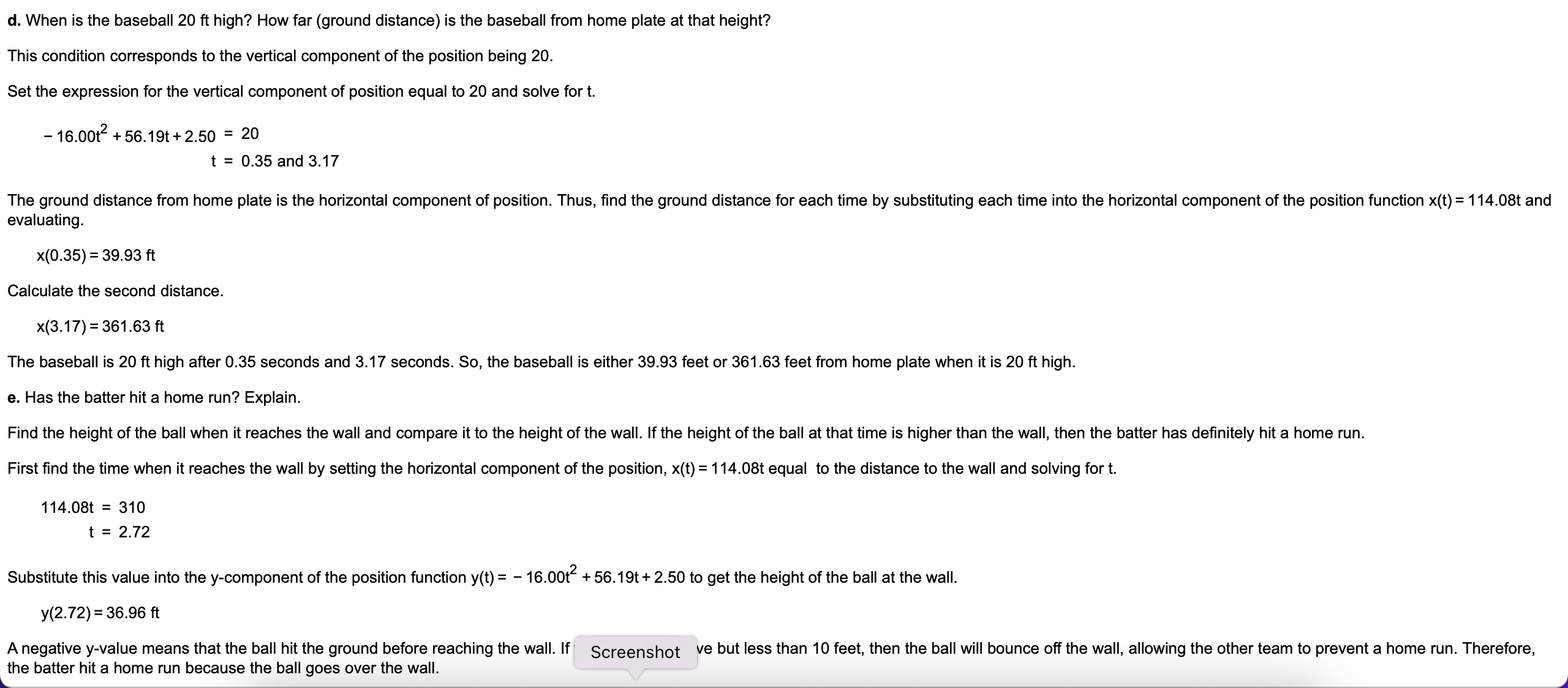
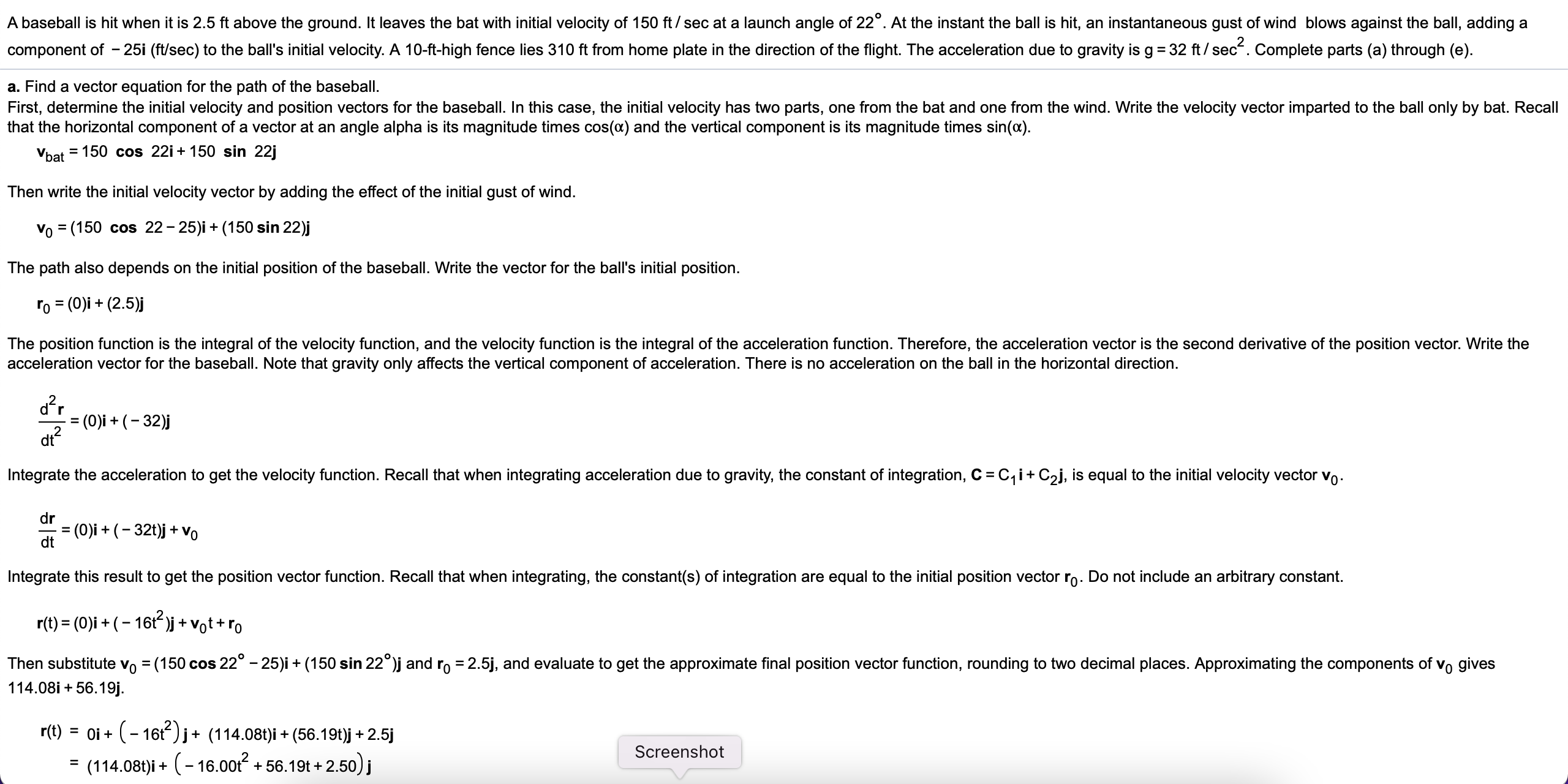
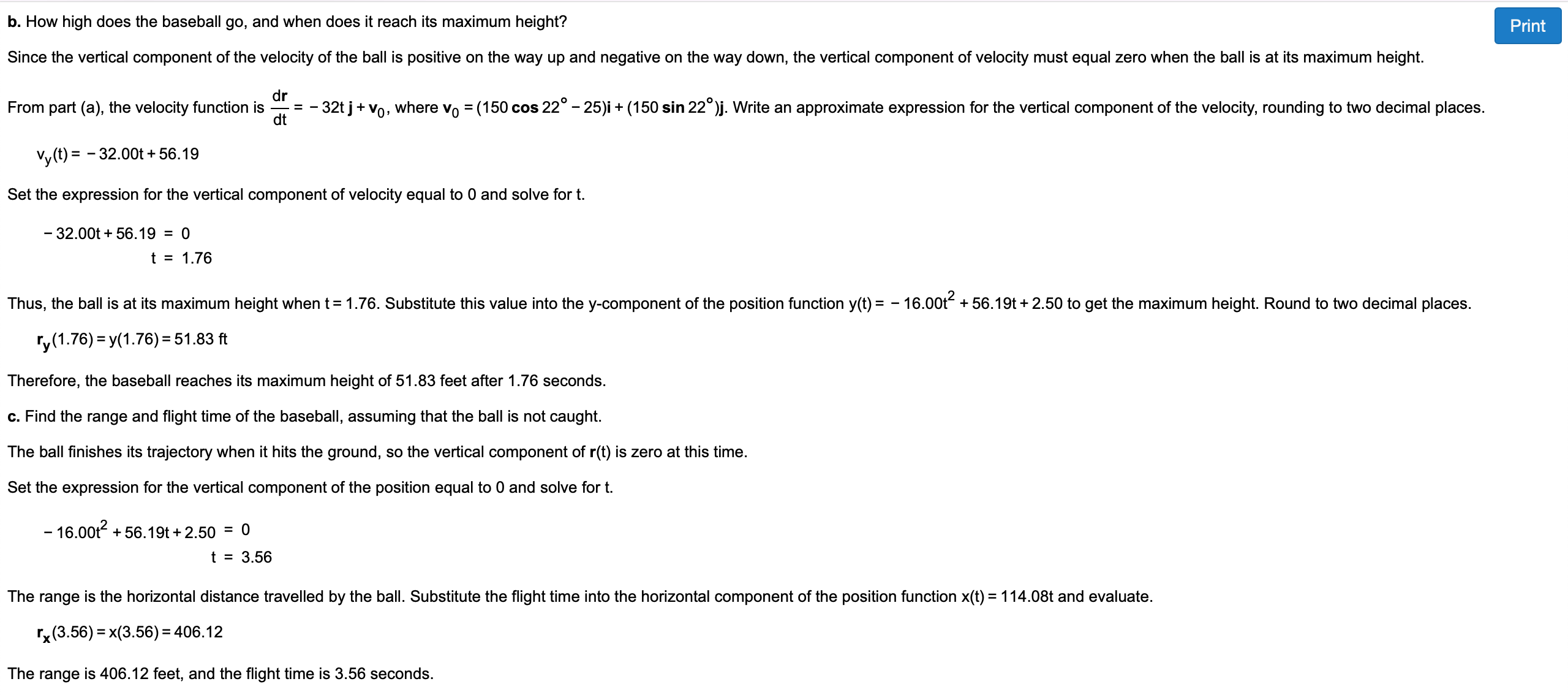
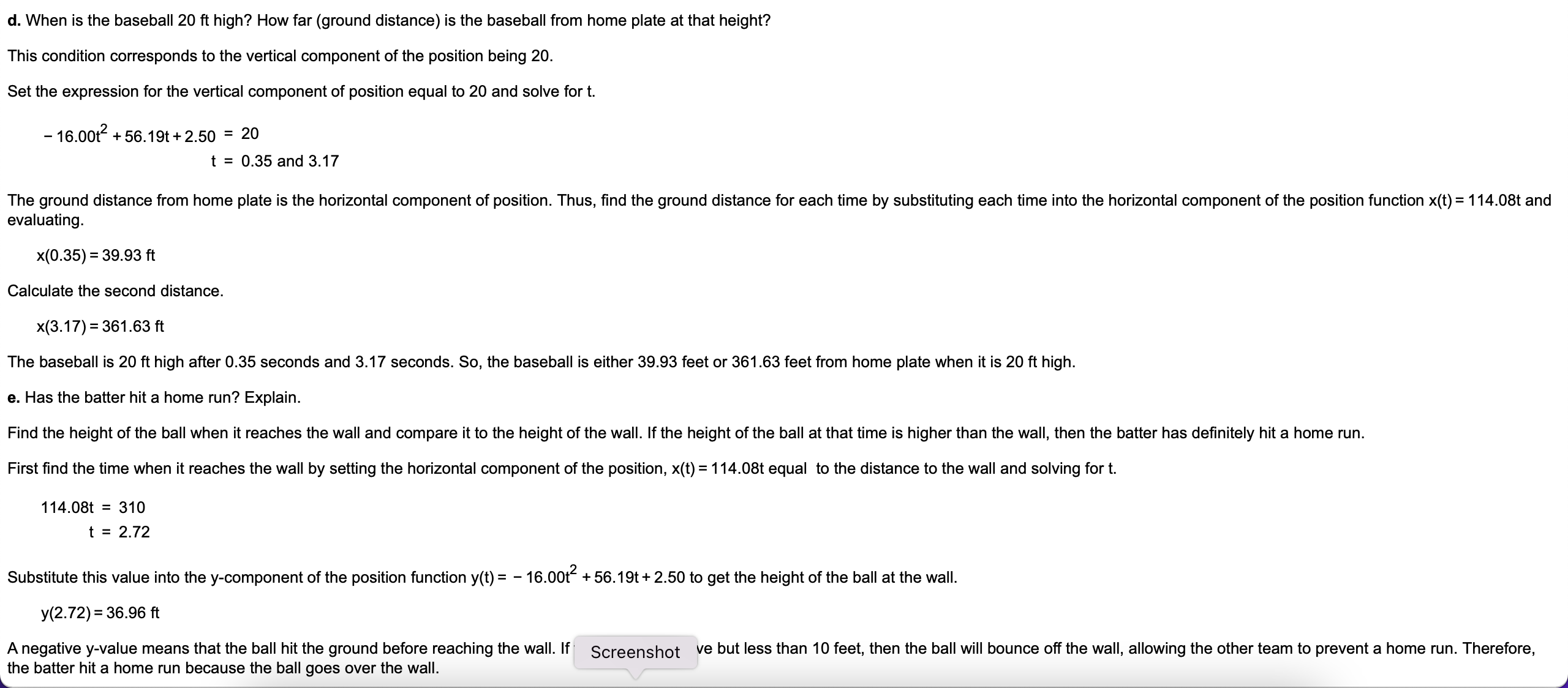
I need help with these this problem please and please answer all parts and please make it legible. I've been having a lot of problems with the tutors today. I've also included an example of an explanation but I'm not getting it.
A baseball is hit when it is 3 ft above the ground. It leaves the bat with initial velocity of 172 ft/ sec at a launch angle of 20. At the instant the ball is hit, an instantaneous gust of wind blows against the ball, adding a component of - 16i (ft/sec) to the ball's initial velocity. A Q--high fence lies 371 ft from home plate in the direction of the ight. The acceleration due to gravity is g = 32 ft/ secz. Complete parts (a) through (e). 3. Find a vector equation for the path of the baseball. I'(t)=( )|+( )I (Use integers or decimals for any numbers in the expression. Round to two decimal places as needed.) A baseball is hit when it is 2.5 ft above the ground. It leaves the bat with initial velocity of 150 ft/ sec at a launch angle of 22. At the instant the ball is hit, an instantaneous gust of wind blows against the ball, adding a component of - 25i (ft/sec) to the ball's initial velocity. A 10-ft-high fence lies 310 ft from home plate in the direction of the ight. The acceleration due to gravity is g = 32 ft/ secz. Complete parts (a) through (e). a. Find a vector equation for the path of the baseball. First, determine the initial velocity and position vectors for the baseball. In this case, the initial velocity has two parts, one from the bat and one from the wind. Write the velocity vector imparted to the ball only by bat. Recall that the horizontal component of a vector at an angle alpha is its magnitude times oos(u) and the vertical component is its magnitude times sin(a). vbm=150 cos 22i+150 sin 22] Then write the initial velocity vector by adding the effect of the initial gust of wind. v0 = (150 cos 22 - 25)I + (150 sln 22)] The path also depends on the initial position of the baseball. Write the vector for the balls initial position. r0 = (0)l + (2.5)] The position function is the integral of the velocity function, and the velocity function is the integral of the acceleration function. Therefore, the acceleration vector is the second derivative of the position vector. Write the acceleration vector for the baseball. Note that gravity only affects the vertical component of acceleration. There is no acceleration on the ball in the horizontal direction. dt2 (0)i + l - 32)] Integrate the acceleration to get the velocity function. Recall that when integrating acceleration due to gravity, the constant of integration, c = C1 I + C2], is equal to the initial velocity vector v0. dr = 0 i+ -32t'+v dt ( ) ( )r o Integrate this result to get the position vector function. Recall that when integrating, the oonstant(s) of integration are equal to the initial position vector r0. Do not include an arbitrary consmnt. r(t)=(0)i+(16t2)j+vot+ r0 Then substitute v0 = (150 cos 22 - 25)i + (150 sin 22)i and r0 = 2.5], and evaluate to get the approximate nal position vector function, rounding to two decimal places. Approximating the components of Va gives 114.08i + 56.19]. r(*) = 01+ ( 16t2) 1+ (114.08t)i+(56.19t)j+2.5j _ _ 2 Screenshot - (114.08t)|+ (-16.00i +56.19t+2.5o)j s i b. How high does the baseball go, and when does it reach its maximum height? Since the vertical component of the velocity of the ball is positive on the way up and negative on the way down, the vertical component of velocity must equal zero when the ball is at its maximum height. From part (a), the velocity function is % = - 32t J + v0, where v0 = (150 cos 22 - 25)l + (150 sln 22)J. Write an approximate expression for the vertical component of the velocity, rounding to two decimal places. vy(t)= 32.00t+56.19 Set the expression for the vertical component of velocity equal to O and solve for t. -32.00t+56.19 = 0 t= 1.76 Thus, the ball is at its maximum height when t= 1 .76. Substitute this value into the y-component of the position function y(t) = -16.00t2 + 56.19t + 2.50 to get the maximum height. Round to two decimal places. ry(1.76)= y(1.76)= 51.83 ft Therefore, the baseball reaches its maximum height of 51 .83 feet after 1.76 seconds. c. Find the range and ight time of the baseball, assuming that the ball is not caught. The ball nishes its trajectory when it hits the ground, so the vertical component of r(t) is zero at this time. Set the expression for the vertical component of the position equal to 0 and solve for t. 16.0012 +56.19t+2.50 t The range is the horizontal distance travelled by the ball. Substitute the ight time into the horizontal component of the position function x(t) = 114.08t and evaluate. \"(3.56) = x(3.56) = 406.12 The range is 406.12 feet, and the ight time is 3.56 seconds. 0 3.56 d. When is the baseball 20 ft high? How far (ground distance) is the baseball from home plate at that height? This condition corresponds to the vertical component of the position being 20. Set the expression for the vertical component of position equal to 20 and solve for t. -16.00t2 +56.19t+2.50 = 20 t = 0.35 and 3.17 The ground distance from home plate is the horizontal component of position. Thus, nd the ground distance for each time by substituting each time into the horizontal component of the position function x(t) = 114.08t and evaluating. x(0.35) = 39.93 ft Calculate the second distance. x(3.17) = 361.63 ft The baseball is 20 ft high after 0.35 seconds and 3.17 seconds. 80, the baseball is either 39.93 feet or 361.63 feet from home plate when it is 20 ft high. e. Has the batter hit a home run? Explain. Find the height of the ball when it reaches the wall and compare it to the height of the wall. If the height of the ball at that time is higher than the wall, then the batter has denitely hit a home run. First nd the time when it reaches the wall by setting the horizontal component of the position, x(t) = 114.08t equal to the distance to the wall and solving for t. 114.08t = 310 t = 2.72 Substitute this value into the y-component of the position function y(t) = - 16.00t2 + 56.19t + 2.50 to get the height of the ball at the wall. y(2.72) = 36.96 ft A negative y-value means that the ball hit the ground before reaching the wall. If' Screenshot ve but less than 10 feet, then the ball will bounce off the wall, allowing the other team to prevent a home run. Therefore, Lthe batter hit a home run because the ball goes over the wall. k





